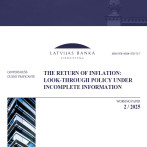Producer prices have the potential to drop
In December 2012, the producer prices in Latvia rose slightly (by 0.2%), without changing in manufacturing. The 3.6% year-on-year rise was primarily the result of a rise in costs in food and energy branches, which also maintained the annual average rise in producer prices by 3.7%.
The trends in producer prices have been relatively beneficial so far indicating that there is no substantial pressure of domestic factors on production costs.
For instance, the rise in energy producer prices (by 0.6%) was primarily the result of a rise in various costs. The Public Utilities Commission approved the rise in heating tariffs in some municipalities (e.g., in Ventspils), where the previous tariffs took effect several years earlier. In mining and quarrying, the price rise could be related, in part, to seasonal factors.
No producer price increase was observed in manufacturing overall and in food production for the domestic market there was even a drop in prices. As indicated by the latest data of the UN Food and Agriculture Organization, the dairy branch is the only one where price rises continue to be the case while the combined agricultural and food price index is dropping. Latvia’s Retail Trade Association published an overview of prices also noting a rise in purchase prices by 4%. This branch, however, did not cause a rise in food manufacturers’ producer prices and even a drop in dairy product consumer prices was observed. Sketching out the trends for 2013, Latvia’s Retail Trade Association mentions a possible drop in dairy prices as the cost-effectiveness in the branch rises because of a drop in fertilizer prices.
The average producer price level in 2012 was primarily influenced by external factors: the drop in food and agricultural product prices at the beginning of the year and the rise in cereal prices in the new harvest season as well as the fluctuations in oil prices that determined the appreciation of energy in the Latvian market. At the beginning of this year, however, there is also positive news in the energy branch.
In January 2013, the sales price of natural gas, has dropped slightly, which has a positive effect on the tariffs of natural gas and costs of thermal energy production, reducing beginning-of-the year rises both in producer and consumer prices. The reduction, however, is not large and, since in 2012, the heating tariffs grew in January as well as in June and July when the population normally does not use heating, the current heating bills give the impression of a sudden skyrocketing of prices in the new season. This is exacerbated by the differences in weather conditions compared to the previous year and, accordingly, by the rise in heating consumption. A further drop in the prices of other energy resources, e.g., fuel, is also very likely (on the supply side, a rise in fuel prices is limited by a peaceful settling of the Middle East conflicts and, from the demand side, a slowdown in economic growth in China). These circumstances could act to reduce the price levels in transportation and agricultural production and limit the price rises of various goods in retail.
Textual error
«… …»






